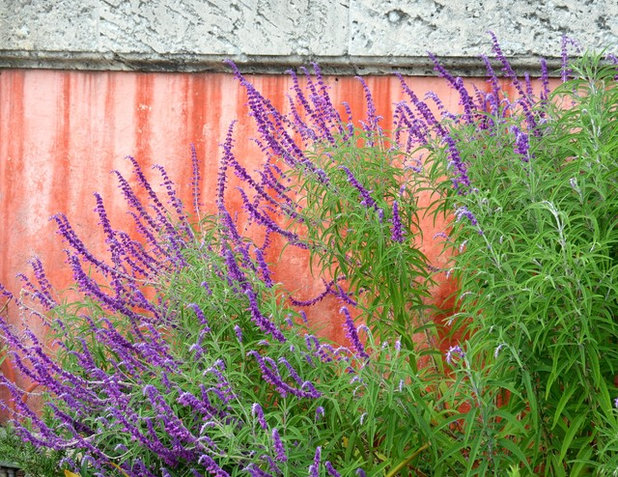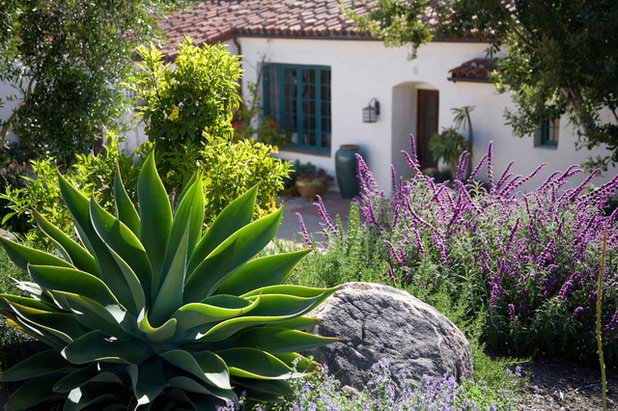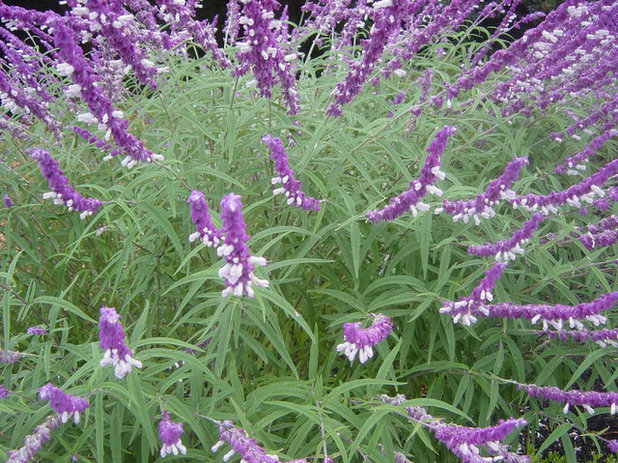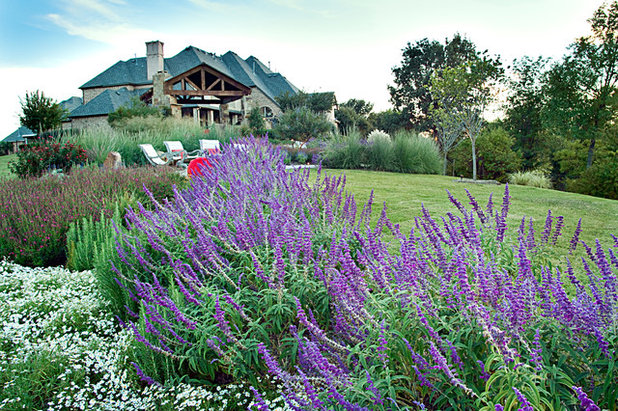Mexican bush sage (
Salvia leucantha) flowers in spring through fall, much to the delight of butterflies and hummingbirds, who enjoy the nectar the flowers provide. This drought-tolerant perennial’s purple spikes entice passersby to reach out and run their fingers over its soft, velvety blooms, while attractive green-gray foliage and white stems provide a visually cooling element in the landscape.

Noelle Johnson Landscape Consulting
Botanical name: Salvia leucanthaCommon name: Mexican bush sage
Origin: Native to the forests of central and eastern Mexico
Where it will grow: Hardy to 15 to 20 degrees Fahrenheit, or minus 9 to minus 7 degrees Celsius (USDA Zone 8b; find your zone)
Water requirement: Drought tolerant once established but does best when watered every 10 days; in low-desert gardens, water weekly for best appearance
Light requirement: Filtered sun
Mature size: 4 to 5 feet tall and 5 to 6 feet wide
Benefits and tolerances: Drought tolerant; attracts butterflies and hummingbirds; deer resistant
Seasonal interest: Flowers in spring, summer and fall
When to plant: Spring or fall
Shown: Mexican bush sage growing in front of a colorful wall at the Vizcaya Museum & Gardens in Miami

Margie Grace - Grace Design Associates
Distinguishing traits. The soft, gray-green leaves range from 1 inch to 2½ inches long. The undersides of the leaves and the stems are white due to the presence of tiny white hairs.
In winter, Mexican bush sage dies back to the ground if temperatures dip into the 20s (Fahrenheit). However, if pruned back to the ground in late winter, it grows back quickly, with the majority of the growth occurring in spring and summer.
Though it has a somewhat rambling nature, it can be controlled by lightly pruning it once or twice during the growing season, which can stimulate additional blooms.
Shown: Spiky foxtail agave (
Agave attenuata)
contrasts beautifully with Mexican bush sage.

Pamela Bateman Garden Design
What most people consider to be the flowers of this shrubby perennial are in reality the calyxes. The calyx is a cup-like structure that holds the base of the actual flower, which is white. The white flowers are ¾-inch long and can be seen peeking out from the purple calyxes.
Like most Salvia species, butterflies and hummingbirds are attracted to the blooms of Mexican bush sage, making it a must-have for those who want to attract wildlife to their garden.
Shown: The white flowers of Mexican bush sage peeking out from the purple calyxes

Derviss Design
How to use it. The spiky flowers of Mexican bush sage create contrasting textures in the garden when it’s paired with softly rounded plants like lantana (
Lantana spp.) and pink fairy duster (
Calliandra eriophylla). Plant it toward the back of perennial beds as an anchor or scatter it throughout a natural-themed landscape.
In addition to providing contrasting texture, planting this Mexican native near yellow- and orange-flowering plants, such as angelita daisy (
Tetraneuris acaulis), damianita (
Chrysactinia mexicana) and ‘Blue Elf’ aloe (
Aloe ‘Blue Elf’), creates great color contrast.

One Specialty Landscape Design, Pools & Hardscape
For a cool color palette using white- and purple-flowering plants, plant Mexican bush sage alongside white-flowering blackfoot daisy (
Melampodium leucanthum), gaura (
Gaura lindheimeri) or bush morning glory (
Convolvulus cneorum).
Shown: Mexican bush sage growing alongside blackfoot daisy

InsideOut Design, Inc
Planting notes. Plant it in well-drained soil amended with compost. Full sun is fine for areas that experience mild summers, but in regions with hot, dry summers, select a location that receives filtered shade for the best results.
Prune Mexican bush sage back to the ground in late winter, and spring growth will rapidly follow. Apply a slow-release fertilizer in spring.





